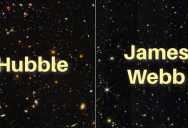The James Webb Telescope Sees More Galaxies In One Image Than The Hubble’s Deepest Look
by Trisha Leigh

It makes sense that the newer, bigger, more powerful telescope scanning space would be bringing back better and bigger images, but for those who have to see to believe, well…the James Webb has you covered.
Back in the day when the Hubble Ultra Deep Field was at the top of the field, we were amazed when it captured light from 10,000 galaxies in one single image.

Image Credit: NASA
Now, the first images from a huge James Webb Space Telescope survey (COSMOS-Web) are said to captures 25,000 galaxies in one image – and that’s only its first stage.
Caitlin Casey, co-principal investigator on the project, talked about the magnitude of the survey in a press release.
“It’s one of the largest JWST images taken so far. And yet it’s just four percent of the data we will get for the full survey. When it is finished, this deep field will be astoundingly large and overwhelmingly beautiful.”
The galaxies in the image consist of spiral galaxies, merger galaxies, the gravity of galaxies creating cosmic lenses, and magnifying older galaxies even further behind them.
What’s wild is that the COSMOS-Web survey is checking out only a small sliver of the sky – a space the size of three full moons – with this camera.
Scientists are hoping to use the images and other data to better understand the Reionization Era, which happened 400,000-1,000,000,000 years after the Big Bang. This is when structures like stars and galaxies emerged, and in the minds of scientists, it’s likely that the hypothetical dark matter evolved alongside them.
According to astrophysicist Santosh Harish, the data collected by the James Webb so far is more than encouraging.
“Sources are literally popping out in every small patch of the observed sky.
With these first observations, we have just barely scratched the surface of what is to come with the completion of this program next year.”
Sounds to me that we all need to keep looking up because there’s a lot more to see!
Categories: NATURE/SPACE
Tags: · Hubble telescope, james web telescope, science, single topic, space, top
Trending on TwistedSifter

Parents Emotionally Manipulated Grandparent Into Babysitting For 5 Days, So They Took The Kids To Disney Without The Parents



